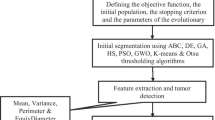Abstract
The speed and accuracy with which the patient affected with brain tumour is diagnosed and monitored, plays a very crucial role in providing treatment to the patient. During the diagnosis of the diseased part, a constant demand is anticipated to easily extract the specific region of interest within the complex medical image. This task of extracting only the diseased portion amid the complex body parts in the complex medical image can be achieved by image segmentation. Accuracy and speed of extracting the points or area of interest within the multipart medical image can be improved by using various evolutionary techniques. Differential evolution (DE) is an efficient evolutionary technique that can be used for solving optimisation problem like image segmentation. The main disadvantage of classical evolutionary technique is its inability to adapt its solution algorithm to a given problem. Owing to this need, more adaptable and flexible algorithms are in demand. Numerous variants of DE exist which differ in their solutions. Here, a variant of differential evolution named as transformed differential evolution (TDE) is presented which has an improved mutation strategy that is optimised to fewer function evaluations. This variant is combined with the Kapur’s multi-level thresholding for segmenting magnetic resonance imaging (MRI) images and to extract only the regions of tumour. The results obtained using TDE with Kapur’s multi-level thresholding were compared with the results using traditional Kapur’s technique and the new results improved profoundly. By introducing TDE in multilevel thresholding, the computational time significantly reduced and the resultant image quality improved greatly.





Similar content being viewed by others
Explore related subjects
Discover the latest articles and news from researchers in related subjects, suggested using machine learning.References
Kapur JN, Prasanna KS, Andrew KCW (1985) A new method for gray-level picture thresholding using the entropy of the histogram. Comput Vis Graph Image Process 29:273–285
Storn R, Price K (1997) Differential evolution—a simple and efficient heuristic for global optimization over continuous spaces. J Glob Optim 11:341–359
Tang Lie, Tian L, Steward Brian L (2000) Color image segmentation with genetic algorithm for in-field weed sensing. Trans ASAE 43(4):1019–1028
Vese Luminita A, Chan Tony F (2002) A multiphase level set framework for image segmentation using the Mumford and Shah model. Int J Comput Vis 50(3):271–293
Tao Wen-Bing, Tian Jin-Wen, Liu Jian (2003) Image segmentation by three-level thresholding based on maximum fuzzy entropy and genetic algorithm. Pattern Recogn Lett 24(16):3069–3078
Kim J, John WF, Anthony Y, Müjdat Ç, Alan SW (2005) A nonparametric statistical method for image segmentation using information theory and curve evolution. IEEE Trans Image Process 14:1486–1502
Omran MGH, Salman A, Engelbrecht AP (2006) Dynamic clustering using particle swarm optimization with application in image segmentation. Pattern Anal Appl 8(4):332
Awad M, Kacem C, Ahmad N (2007) Multicomponent image segmentation using a genetic algorithm and artificial neural network. IEEE Geosci Remote Sens 4:571–575
Swagatam D, Abraham A, Konar A (2008) Automatic clustering using an improved differential evolution algorithm. IEEE Trans Syst Man Cybern A 38:218–237
Maitra Madhubanti, Chatterjee Amitava (2008) A hybrid cooperative–comprehensive learning based PSO algorithm for image segmentation using multilevel thresholding. Expert Syst Appl 34(2):1341–1350
Jin F, Farook S, Daniel YTG (2009) An acoustical respiratory phase segmentation algorithm using genetic approach. Med Biol Eng Comput 47:941–953
Maulik Ujjwal (2009) Medical image segmentation using genetic algorithms. IEEE Trans Inf Technol B 13(2):166–173
Ribeiro A, Ranz J, Burgos-Artizzu XP, Pajares G, Sanchez del Arco MJ, Navarrete L (2011) An image segmentation based on a genetic algorithm for determining soil coverage by crop residues. Sensors 11(6):6480–6492
Gulati N, Poonam P (2013) Genetic algorithms for image segmentation using active contours. J Glob Res Comput Sci 4:34–37
Bhandari AK, Vineet KS, Anil K, Girish KS (2014) Cuckoo search algorithm and wind driven optimization based study of satellite image segmentation for multilevel thresholding using Kapur’s entropy. Expert Syst Appl 41:3538–3560
Manikandan S, Ramar K, Willjuice Iruthayarajan M, Srinivasagan KG (2014) Multilevel thresholding for segmentation of medical brain images using real coded genetic algorithm. Measurement 47:558–568
Mesejo P, Valsecchi A, Marrakchi-Kacem L, Cagnoni S, Damas S (2015) Biomedical image segmentation using geometric deformable models and metaheuristics. Comput Med Image Graph 43:167–178
Ramadas M, Abraham A, Kumar S (2019) FSDE-forced strategy differential evolution used for data clustering. J King Saud Univ Comput Inf Sci 31(1):52–61
Arora T, Renu D (2016) Correlation-based feature selection and classification via regression of segmented chromosomes using geometric features. Med Biol Eng Comput 55(5):733–745
Bermejo E, Chica M, Damas S, Salcedo-Sanz S, Cordón O (2018) Coral Reef Optimization with substrate layers for medical Image Registration. Swarm Evol Comput 42:138–159
Naidu MSR, Kumar PR, Chiranjeevi K (2018) Shannon and fuzzy entropy based evolutionary image thresholding for image segmentation. AEJ 57(3):1643–1655
Scelsi MA, Khan RR, Lorenzi M, Christopher L, Greicius MD, Schott JM, Ourselin S, Altmann A (2018) Genetic study of multimodal imaging Alzheimer’s disease progression score implicates novel loci. Brain 141(7):2167–2180
Das S, De S, Bhattacharyya S, Hassanien AE (2019) Color MRI image segmentation using quantum-inspired modified genetic algorithm-based FCM. In: Recent trends in signal and image processing. Springer, Singapore, pp 151–164
Rundo L, Tangherloni A, Nobile MS, Militello C, Besozzi D, Mauri G, Cazzaniga P (2019) MedGA: a novel evolutionary method for image enhancement in medical imaging systems. Expert Syst Appl 119:387–399
Author information
Authors and Affiliations
Corresponding author
Ethics declarations
Conflict of interest
The author(s) declare(s) that there is no conflict of interest.
Additional information
Publisher's Note
Springer Nature remains neutral with regard to jurisdictional claims in published maps and institutional affiliations.
Rights and permissions
About this article
Cite this article
Ramadas, M., Abraham, A. Detecting tumours by segmenting MRI images using transformed differential evolution algorithm with Kapur’s thresholding. Neural Comput & Applic 32, 6139–6149 (2020). https://doi.org/10.1007/s00521-019-04104-0
Received:
Accepted:
Published:
Issue Date:
DOI: https://doi.org/10.1007/s00521-019-04104-0




